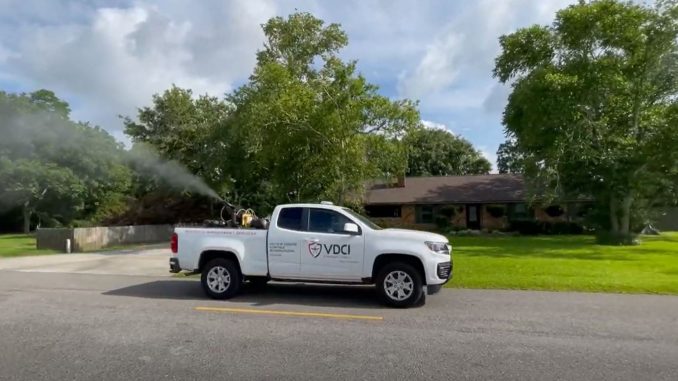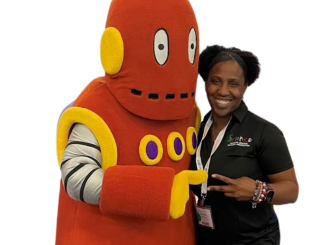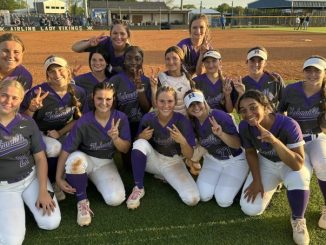
Based on recent data tracked by VDCI, the local contractor that operates St. Charles Parish Mosquito Control services, St. Charles Parish and surrounding parishes may currently be experiencing some of the highest mosquito infestation levels the area has seen in decades.
VDCI is contracted to supply St. Charles Parish’s mosquito services, which it also provides to several other surrounding parishes. The company conducts surveillance, aerial spraying, ground spraying via special fogging trucks, testing along with other treatment methods. There are currently nine VDCI employees dedicated to servicing St. Charles Parish at present time.
“In my 40-year experience of [mosquito control], I can say that this is the worst September and October I can remember,” Tommy Heurtin, longtime St. Charles Parish mosquito control manager and VDCI employee, said.
VDCI tracks mosquito population throughout St. Charles Parish weekly using a trap system, each trap’s mosquito count giving VDCI sample data to estimate mosquito populations in each area; around 25 to 30 fixed location traps are used and additional auxiliary, moveable traps are set all over the parish. Rainfall data is also reviewed.
Traps are checked and mosquitoes counted in each trap several times per week, then compared to historical figures, giving VDCI an idea of where their efforts are most needed each week within St. Charles Parish. Mosquito and trap data are also sent to a state testing lab in Baton Rouge weekly for West Nile virus testing.
“They come on at sun set and click off at sunrise,” Heurtin said of VDCI’s specialized traps. “They’re basically designed to give you an average of the population of adult mosquitoes in that area.”
VDCI’s recent mosquito trap data in September and October, when mosquito populations historically become much higher each year, reveal what many St. Charles Parish residents may have already suspected – mosquito populations in the last two months appear to have exploded well beyond their recent historical norms. VDCI handles several other surrounding parishes, and reports other nearby parishes are experiencing the same mosquito increase problems in areas like St. John, St. James, Jefferson and St. Bernard Parishes.
Rainfall this year surprisingly may not be entirely to blame, Heurtin said, due to the species of mosquito recent trap data has indicated St. Charles Parish has a high population growth in. Rainfall does influence mosquito populations, the longtime mosquito control expert said, but how they are affected depends on the species of mosquito. South Louisiana has two major species of mosquitoes – floodwater species and permanent water species – with the reproduction of each affected by rainfall differently.
It is the permanent water species, which are less affected by rainfall, Heurtin said, that St. Charles Parish trap data indicates is currently driving higher mosquito populations. VDCI has responded by adding additional aerial spraying to help reach areas that are unreachable by any other method, focusing on trap data and using that information to help ground crews know where to double down on its efforts.
Truck sprayers that arrive in local neighborhoods to fog streets with mosquito treatment are perhaps the most visible aspect of VDCI’s operation but are only a portion of the various treatment methods VDCI uses to control mosquitoes within St. Charles Parish.
Heurtin said one of VDCI’s most important functions is its roving team of mosquito technicians who inspect areas all over the parish daily, looking for the hundreds of ruts and pockets of water that may breed mosquitoes.
“The best defense for any mosquito problem, and especially encephalitis, is to eliminate them in the larval stage,” Heurtin said, citing VDCI’s daily inspections and water treatment as the parish’s most effective method for mosquito control.
Once mosquitoes hatch and are moving and flying, Heurtin said, they become more difficult to kill using fogging methods, but while stationary in the larval stage on the ground, they are much easier to eliminate. One female mosquito can lay anywhere from 100 to 300 eggs at a time, making larval treatment far more effective in controlling mosquito populations.
VDCI also provides ground spraying via its special fogging trucks, and upon special request can even hand fog areas for special events where they may be large outdoor gatherings of people planned such as weddings. VDCI’s fogging trucks are run throughout five parish zones weekly.
“We don’t have a set schedule,” Heurtin said of when its fogging trucks hit what streets each week. “Our goal is to hit every zone weekly at least once a week. On good weeks where the weather doesn’t stop us, or we don’t have machine issues… we try to let everybody see the truck at least once a week.”
Weather, trap data, lab viral results and mosquito population data dictating where weekly efforts are focused most. Heurtin says VDCI also tests the efficacy of its mosquito-killing solutions regularly to make sure local mosquito populations are not building up a resistance, and to adjust where needed.
While Mother Nature continues to bring higher mosquito populations, Heurtin said there are a few things local residents can do around their own properties to help control mosquito populations, such as monitor pets that may go outdoors for mosquitoes, as well as be vigilant of any surface area, creases in boat covers, pots or container in and around their property that may collect surface water, taking care to empty those containers of water to prevent mosquitoes from breeding in them.
“The only way to [eliminate mosquitoes that breed inside water containers on private property] is to get into your yard, fog it and clean up your yard,” Heurtin said. “We can’t physically do that in every yard in the parish, so we ask the residents– please police your yard.”




Be the first to comment